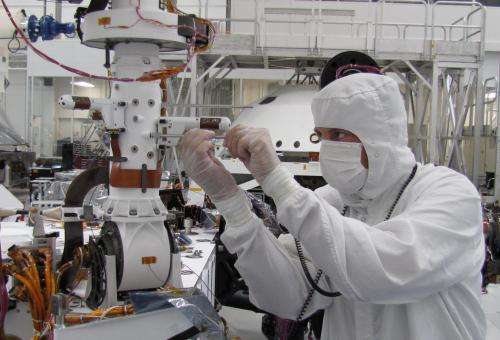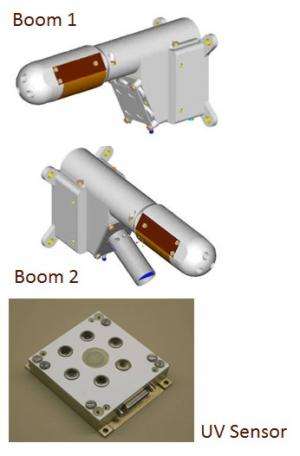Temperatures measured at Gale Crater higher than expected

(Phys.org)—Preliminary weather reports from the Curiosity's Remote Environment Monitoring Station (REMS) are showing some surprisingly mild temperatures during the day. Average daytime air temperatures have reached a peak of 6 degrees Celsius at 2pm local time. A Martian day – known as a Sol – is slightly longer than Earths at 24 hours and 39 minutes. Temperatures have risen above freezing during the day for more than half of the Martian Sols since REMS started recording data. Because Mars's atmosphere is much thinner than Earth's and its surface much drier, the effects of solar heating are much more pronounced. At night the air temperatures sink drastically, reaching a minimum of -70 degrees just before dawn.
NASA's Mars Science Laboratory touched down in Gale Crater on 5th August 2012 close to the equator of Mars at a latitude of 4.5 degrees south. The southern hemisphere of Mars is approaching springtime, leading to speculation about possible temperatures for at the height of Martian summer.
"That we are seeing temperatures this warm already during the day is a surprise and very interesting," says Dr Felipe Gómez of the Centro de Astrobiología in Madrid. "It's very early days and we are only now being able to test our models against REMS observations. If this warm trend carries on into summer, we might even be able to foresee temperatures in the 20s – and that would be really exciting from a habitability point of view. In the daytimes, we could see temperatures high enough for liquid water on a regular basis. But it's too soon to tell whether that will happen or whether these warm temperatures are just a blip."

REMS pressure sensors have also been recording slightly higher pressures than expected. In winter, Mars becomes cold enough for carbon dioxide at the poles to freeze, forming seasonal ice caps. Since carbon dioxide makes up most of the atmosphere, this process causes the overall atmospheric pressure to vary through the year. Models and data from previous mission predicted that Curiosity would land around the minimum mean pressure for the year. So far, the pressure measurements from REMS do indeed appear to be rising slowly. The pressure has risen from a daily average of around 730 pascals during the first three weeks after landing to around 750 pascals – a tiny fraction of the average pressure at sea level on Earth.
"The pressure data show a very significant daily variation of pressure, following a fairly consistent cycle from Sol-to-Sol. The minimum is near 685 pascals and the maximum near 780 pascals. The majority of the variation is due to large scale waves in the atmosphere called tides. These tides are different from tides in the Earth's ocean because they are forced by heating due to the sun rather than the gravitational pull of the Moon. The tides are sensitive to the distribution of cloud and dust in the atmosphere, and also the large scale pattern of winds – rather like the jet streams on Earth," says Javier Gómez-Elvira, the Principal Investigator of the REMS Instrument.
Provided by Europlanet




















